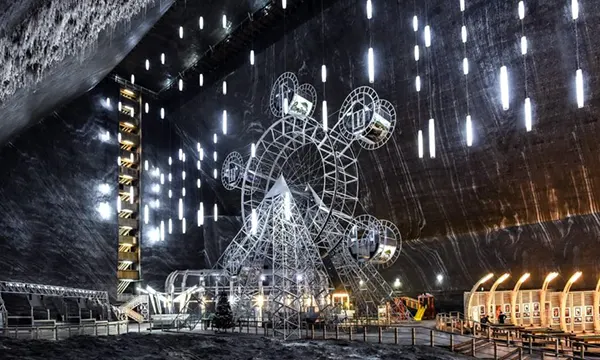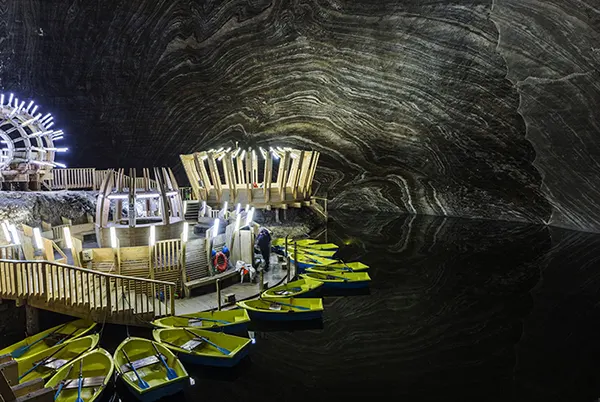
The Mysterious Salt Mine of Salina Turda (Romania): An Underground Wonder of Transylvania
Hidden beneath the rolling hills of Transylvania lies one of Romania’s most fascinating landmarks — Salina Turda. Once an ordinary salt mine, today it stands as a breathtaking underground attraction combining history, geology, and modern engineering. Its vast caverns, shimmering salt formations, and innovative restoration have transformed it into a site of global significance and a symbol of how heritage and tourism can coexist harmoniously.
From Ancient Extraction to Modern Marvel
Salina Turda’s story dates back to antiquity, with historical evidence suggesting salt extraction began during Roman times. The mine served as a major source of salt — an essential commodity for food preservation and trade — for centuries. Over the years, miners carved tunnels and chambers up to 120 metres deep, creating a labyrinth that reflects the evolution of mining techniques across different eras.
After operations ceased in 1932, the mine remained largely forgotten until the late 20th century. Restoration efforts, launched in the 1990s and completed in 2010, turned this historic site into one of Europe’s most distinctive underground attractions. The project focused on preserving natural salt structures while introducing modern amenities for visitors, ensuring both safety and authenticity.
Today, Salina Turda represents not only Romania’s industrial heritage but also a successful example of sustainable tourism. Every corner tells a story — from the carved walls of the Terezia mine to the spiral staircase descending into the echoing depths of the Rudolf hall.
Architectural and Geological Uniqueness
What distinguishes Salina Turda from other salt mines is its extraordinary interior architecture. The Rudolf mine, the largest chamber, measures nearly 80 metres high and features intricate salt patterns naturally formed over millennia. The air inside is rich in minerals and known for its therapeutic properties, making the mine popular for both recreation and health treatments.
The engineering achievements within the mine are equally impressive. Visitors can ride a panoramic lift to the lower levels, where a subterranean lake hosts small boats and wooden walkways illuminated by futuristic lighting. This blend of raw geology and contemporary design gives the space an almost otherworldly atmosphere.
Every structure — from the amphitheatre to the ferris wheel — was designed with environmental sensitivity in mind. The goal was to enhance the visitor experience without disturbing the fragile microclimate or the geological integrity of the salt formations.
A Subterranean Attraction for All Seasons
Salina Turda attracts hundreds of thousands of tourists each year, regardless of season. The underground temperature remains steady at around 10°C, making it a refreshing escape during Romania’s hot summers and a cosy refuge in winter. The consistent climate also helps maintain the mine’s therapeutic qualities, which are especially beneficial for respiratory conditions.
Beyond sightseeing, the complex includes a wellness centre, a mini-golf course, a bowling alley, and an underground concert hall where acoustic performances create a mesmerising sound experience. Families, adventurers, and history enthusiasts all find something special within its walls.
Importantly, the management team continuously invests in maintenance and educational initiatives. Guided tours highlight both scientific and historical aspects, helping visitors appreciate the complexity of salt mining and the environmental value of preserving such natural wonders.
Scientific and Educational Importance
Beyond its visual appeal, Salina Turda plays a key role in geological and environmental research. Scientists study its stable air composition, microclimate, and mineral layers to understand natural processes of salt formation and preservation. The site has also become a reference point for discussions on sustainable heritage restoration.
Educational programmes for students and researchers promote awareness of geology and history, making the mine not just a tourist site but a living classroom. Partnerships with universities across Europe further enhance its scientific profile and ensure ongoing exploration of its natural and cultural potential.
In recent years, Salina Turda has been featured in documentaries and academic publications, strengthening its reputation as both a cultural monument and a scientific laboratory hidden deep beneath Transylvania’s surface.

Salina Turda in the 21st Century
Today, Salina Turda is recognised as one of Romania’s top destinations and a benchmark for the adaptive reuse of industrial heritage. It consistently ranks among the most beautiful underground places in the world, attracting travellers from across Europe and beyond. Local authorities have worked closely with conservation experts to ensure its long-term protection and sustainability.
In 2025, continued investments in accessibility, renewable energy use, and digital visitor guides show Romania’s commitment to blending innovation with cultural preservation. The site’s success has also encouraged similar restoration projects in other regions with historical mines.
Salina Turda stands as proof that respect for history can coexist with technological progress. It offers a model for how natural and human-made spaces can merge into something truly exceptional — a timeless testimony to human creativity beneath the earth’s surface.
A Symbol of Cultural and Environmental Harmony
Salina Turda is more than a tourist attraction; it is a reflection of Romania’s dedication to preserving its identity while embracing the future. The mine connects people with nature, science, and history in a way few other sites can achieve. Its transformation from a working mine into an international landmark demonstrates what can be accomplished when heritage is valued as a living part of modern society.
With its balance of education, entertainment, and environmental responsibility, Salina Turda continues to inspire visitors and conservationists alike. Its legacy extends far beyond the tunnels, reminding everyone that even the deepest places on Earth can reveal humanity’s brightest achievements.
For travellers seeking authenticity, knowledge, and beauty, Salina Turda remains one of Europe’s most remarkable underground treasures — a masterpiece carved from salt and time itself.
